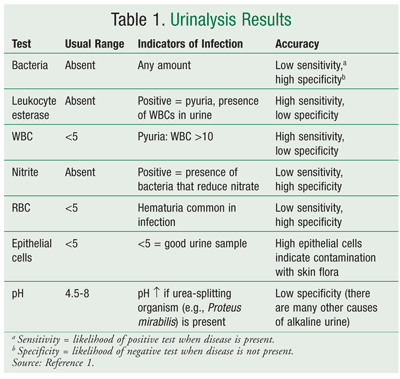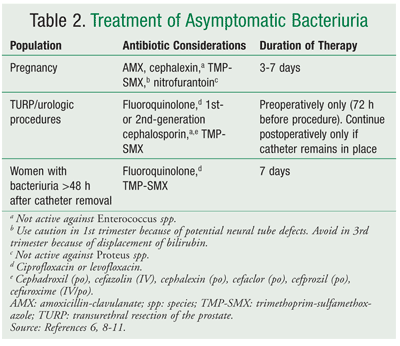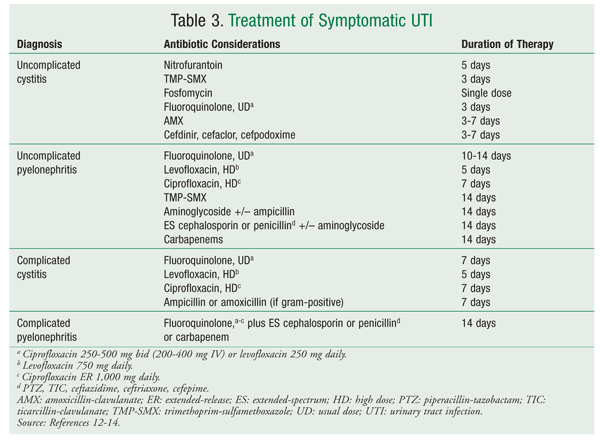ABSTRACT: Urinary tract infection (UTI) is one of the most commonly diagnosed infections in both outpatient and inpatient populations. In order to make an accurate diagnosis, it is essential for practitioners to understand the value and limitations of urinalysis and urine culture. Use of these tests in conjunction with an assessment of urinary symptoms will yield a diagnosis of either asymptomatic bacteriuria or symptomatic UTI. Pharmacists can play a key role in recommending that antibiotic therapy be withheld when it is not indicated, in addition to providing guidance on appropriate antibiotic selection when treatment is warranted.
Urinalysis is a valuable diagnostic tool for many common disease states. Urinalysis is the most frequently used test for the evaluation of potential urinary tract infection (UTI). In addition, it can provide useful information related to screening and diagnosis of other conditions, including malignancy, proteinuria, glycosuria, ketonuria, and renal calculi.1 Accurate interpretation of urinalysis results is a key concept for health care providers in order to diagnose and treat patients appropriately. This article will focus primarily on the interpretation of urinalysis and subsequent urine culture in the diagnosis and treatment of UTIs.
Overview
UTI is the second most common type of infection, accounting for approximately 10 million visits to health care providers in the United States each year.2 Many of these visits take place in the emergency department, where urinalysis can provide rapid diagnostic results. However, because urinalysis is so commonly ordered in the emergency care setting, there is concern that misinterpretation may lead to overtreatment of UTI and increased antibiotic use. Treatment of a UTI should never be initiated based upon urinalysis alone; patient history and subsequent urine culture results are extremely important for diagnosing UTI. In a recent study of 153 women aged 70 years and older with a diagnosis of UTI made in the emergency department, 43% of patients did not have microbiological evidence of a UTI, yet 95% of culture-negative patients received antibiotic therapy.3 Overtreatment of UTI leads to higher health care costs, increased antibiotic exposure, a greater number of adverse reactions, antimicrobial resistance, and other unintended outcomes, such as Clostridium difficile infection.
Clinical Presentation
It is vital to understand the symptoms of UTI that may prompt an order for a urinalysis and urine culture. Urinary symptoms should be used in conjunction with test results to diagnose UTI. While many of the symptoms seem intuitive, there have been some recent changes to the definitions of the nonspecific symptoms that many health care providers have come to associate with UTI.
Cystitis/Lower UTI Symptoms: The most common symptoms associated with lower UTI include dysuria or acute pain, frequent urination, urgency, and incontinence. Occasionally, hematuria, cloudy urine, or foul-smelling urine may be present.4,5
Pyelonephritis/Upper UTI Symptoms: Compared with cystitis, pyelonephritis often has a more severe, systemic presentation. In addition to the urinary symptoms seen in cystitis, patients may also present with suprapubic pain, costovertebral angle tenderness (flank pain), fever, chills, elevated WBC count, nausea, and vomiting.4,5
Nonspecific Symptoms: Nonspecific symptoms, most notably mental-status changes, have become associated with a suspicion of UTI in elderly patients. This can been attributed to the inclusion of these generalized symptoms in previous consensus-based criteria for diagnosing UTI in residents of skilled nursing facilities.3 It remains controversial whether isolated nonspecific symptoms in the elderly can be directly related to UTI. The most recent definitions of UTI in long-term care facilities do not include acute mental-status change as a symptom of UTI in noncatheterized patients. In patients without an indwelling catheter, mental-status change or acute functional decline without an alternative diagnosis may be used as a diagnostic criterion for UTI, but only if leukocytosis is present as well.5 Based on this definition, less emphasis should be placed on nonspecific symptoms unless the patient is catheterized or has unexplained leukocytosis.
Urinalysis Interpretation
There are several factors to consider when evaluating urinalysis for indicators of infection. The most obvious indicator of bacterial infection in the urine is the presence of bacteria; this is often quantified in terms of the number of bacteria per high-power field (HPF). Any amount of bacteria in the urine may suggest UTI in a symptomatic patient, but the threshold for the classic definition of bacteriuria is 5+, which is roughly equivalent to 100,000 colony-forming units (CFUs)/mL.1 An alternative definition for bacteriuria is 2+ present on urinalysis (representing 100 CFU/mL); this may be considered positive in selected populations, such as catheterized or strongly symptomatic patients.
Pyuria, which is defined as urine WBC >10 or positive leukocyte esterase, indicates the presence of inflammation. However, pyuria does not necessarily mean that the inflammation is a result of infection. Pyuria is associated with low specificity and positive predictive value, yet its absence virtually eliminates infection as a cause, with a negative predictive value of nearly 90%.1,3
Evaluation for the presence of nitrites in the urine is also of value. A test that is positive for nitrites in the urine indicates the presence of an organism that reduces nitrate.1 However, not all urinary pathogens are nitrate reducers. A positive test is highly specific for bacterial infection, but a negative test does not exclude infection, giving this test low sensitivity.1 In addition, false-positive results for nitrite will occur if the dipstick is exposed to air or phenazopyridine, a common prescription and OTC product (e.g., Pyridium, AZO) used as a urinary analgesic.1
Urinalysis interpretation is summarized in TABLE 1, with the first four tests most commonly evaluated for information leading to the diagnosis of UTI.1 At many institutions, a reflex urine culture is sent if the urine meets set criteria regardless of patient symptoms. Frequently, if any of the first four tests listed in TABLE 1 are positive, a reflex urine culture will be ordered. This can create a situation in which a positive urine culture may prompt treatment with antibiotics, even if the patient is asymptomatic. Overtreatment of asymptomatic bacteriuria is a common occurrence that can be prevented with careful application of guideline-based recommendations.
Approach to the Asymptomatic Patient
A therapeutic challenge arises when a patient has urinalysis findings or culture results that are consistent with UTI, yet does not experience any urinary symptoms. The prevalence of this condition, known as asymptomatic bacteriuria, increases with age.6,7 Asymptomatic bacteriuria has been reported in 50% of women in long-term care facilities, and the prevalence in men drastically increases in those older than 60 years.6 Routine screening of asymptomatic patients is not recommended, according to the Infectious Diseases Society of America guidelines.6 The only populations with a proven benefit from urinalysis and culture screening are pregnant patients and patients with a planned transurethral resection of the prostate or other urologic procedure in which mucosal bleeding is expected.6 Treatment also may be considered in women with bacteriuria more than 48 hours after catheter removal.6,8 If asymptomatic bacteriuria is identified in a patient from one of these populations, treatment should be initiated as described in TABLE 2.6,8-11 Antibiotic therapy should be started empirically, but it may require modification depending upon the organism identified in the urine culture.
Approach to the Symptomatic Patient
Once a diagnosis of UTI has been made based upon symptoms and urinalysis results, the next step is to start empirical antibiotic therapy and await culture and susceptibility results. As previously discussed, UTI symptoms may be defined as lower (cystitis), upper (pyelonephritis), or nonspecific. Another classification of UTI that can determine treatment and therapy duration is uncomplicated versus complicated.
Uncomplicated UTI is defined as a UTI without structural or urologic abnormalities.12 Uncomplicated cystitis is often associated with healthy community-dwelling women.13 Uncomplicated infections are rare in males because of the anatomical feature of a longer urethra, which protects against the ascending spread of bacteria. Uncomplicated UTI in young males may be a result of homosexual activity or noncircumcision, but otherwise UTIs in men are often classified as complicated.14
Complicated UTI has various definitions, but the most consistent patient features are presence of foreign body, obstruction, immunosuppression, renal failure or transplantation, urinary retention, or pregnancy.12
Antimicrobial selection for treatment of symptomatic UTI should be based on the most likely pathogens. The most common pathogen in uncomplicated infections is Escherichia coli, followed by other Enterobacteriaceae, including Proteus mirabilis, Klebsiella pneumoniae, and Staphylococcus saprophyticus.13 Local susceptibility data on these uropathogens should be used to direct empirical antibiotic prescribing, since resistance has increased in recent years. In patients with complicated UTI, the same pathogens may be present; however, more resistance is seen with gram-negative organisms. Some of the most common resistant uropathogens are extended-spectrum beta-lactamases, which are common with E coli, K pneumoniae, and P mirabilis species.12 Other multidrug-resistant pathogens, such as Serratia, Citrobacter, Enterobacter, Pseudomonas, and Acinetobacter species, become more common in health care–associated infections. Infections with gram-positive organisms such as staphylococci and enterococci are also more common in complicated UTI.12 If a urinary catheter is in place, removal of the catheter and culture from midstream urine or a fresh catheter should be used to direct therapy.8
Once the likely pathogens have been established, an appropriate antibiotic that will achieve good urinary concentrations should be prescribed. Urine culture results should be used to de-escalate or change therapy, if needed, and the recommended duration of therapy should be followed to prevent excessive antimicrobial exposure. TABLE 3 provides the recommended agents and therapy durations for symptomatic UTI.13,14
Conclusion
Clinical interpretation of urinalysis and urine culture results requires both an understanding of the significance of test characteristics and the incorporation of patient symptoms. At many institutions, pharmacists play a key role in reviewing positive urinalysis and urine culture results as a part of antimicrobial stewardship and clinical activities. It can be tempting to simply recommend an antibiotic based on test results, but in order to prevent overtreatment of asymptomatic patients, a careful review of symptoms should also be conducted. Pharmacists can be proactive in implementing antibiotic prescribing pathways that provide empirical antibiotic recommendations utilizing local susceptibility data.
REFERENCES
1. Simerville JA, Maxted WC, Pahira JJ. Urinalysis: a comprehensive review. Am Fam Physician. 2005;71:1153-1162.
2. Schappert SM, Burt CW. Ambulatory care visits to physician
offices, hospital outpatient departments, and emergency department:
United States, 2001–02. National Center for Disease Statistics. Vital Health Stat. 2006;13.
3. Gordon LB, Waxman MJ, Ragsdale L, Mermel LA. Overtreatment of
presumed urinary tract infection in older women presenting to the
emergency department. J Am Geriatr Soc. 2013;61:788-792.
4. Smith CL. Infectious diseases. In: Updates in Therapeutics: The Pharmacotherapy Preparatory Course, 2009 Edition. Vol 1. Lenexa, KS: American College of Clinical Pharmacy; 2009.
5. Stone ND, Ashraf MS, Calder J, et al. Surveillance definitions of
infections in long-term care facilities: revisiting the McGeer criteria.
Infect Control Hosp Epidemiol. 2012;33:965-977.
6. Nicolle LE, Bradley S, Colgan R, et al. Infectious Diseases
Society of America guidelines for the diagnosis and treatment of
asymptomatic bacteriuria in adults. Clin Infect Dis. 2005;40:643-654.
7. Juthani-Mehta M. Asymptomatic bacteriuria and urinary tract infection in older adults. Clin Geriatr Med. 2007;23:585-594.
8. Schnarr J, Smaill F. Asymptomatic bacteriuria and symptomatic urinary tract infections in pregnancy. Eur J Clin Invest. 2008;38(suppl 2):50-57.
9. Wolf JS Jr, Bennett CJ, Dmochowski RR, et al. Best practice policy statement on urologic surgery antimicrobial prophylaxis. J Urol. 2008;179:1379-1390.
10. Comparison of cephalosporins. Pharmacist’s Letter/Prescriber’s Letter. July 2012;280706.
11. Hooton TM, Bradley SF, Cardenas DD, et al. Diagnosis, prevention,
and treatment of catheter-associated urinary tract infection in adults:
2009 International Clinical Practice Guidelines from the Infectious
Diseases Society of America. Clin Infect Dis. 2010;50:625-663.
12. Levison ME, Kaye D. Treatment of complicated urinary tract
infections with an emphasis on drug-resistant gram-negative
uropathogens. Curr Infect Dis Rep. 2013;15:109-115.
13. Gupta K, Hooton TM, Naber KG, et al. International clinical
practice guidelines for the treatment of acute uncomplicated cystitis
and pyelonephritis in women: a 2010 update by the Infectious Diseases
Society of America and the European Society for Microbiology and
Infectious Diseases. Clin Infect Dis. 2011;52:e103-e120.
14. Coyle EA, Prince RA. Urinary tract infections and prostatitis. In: DiPiro JT, Talbert RL, Yee GC, et al, eds. Pharmacotherapy: A Pathophysiologic Approach. 8th ed. New York, NY: McGraw-Hill Medical; 2011.
To comment on this article, contact rdavidson@uspharmacist.com.








